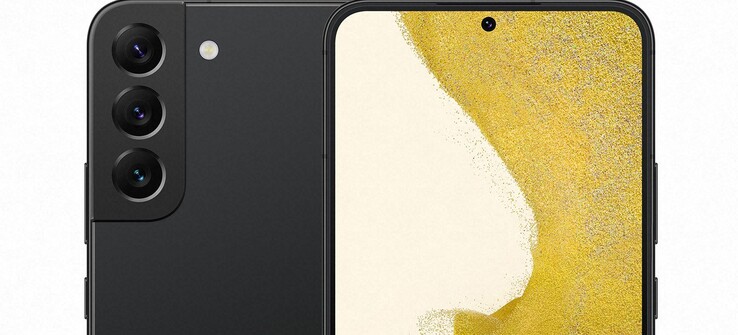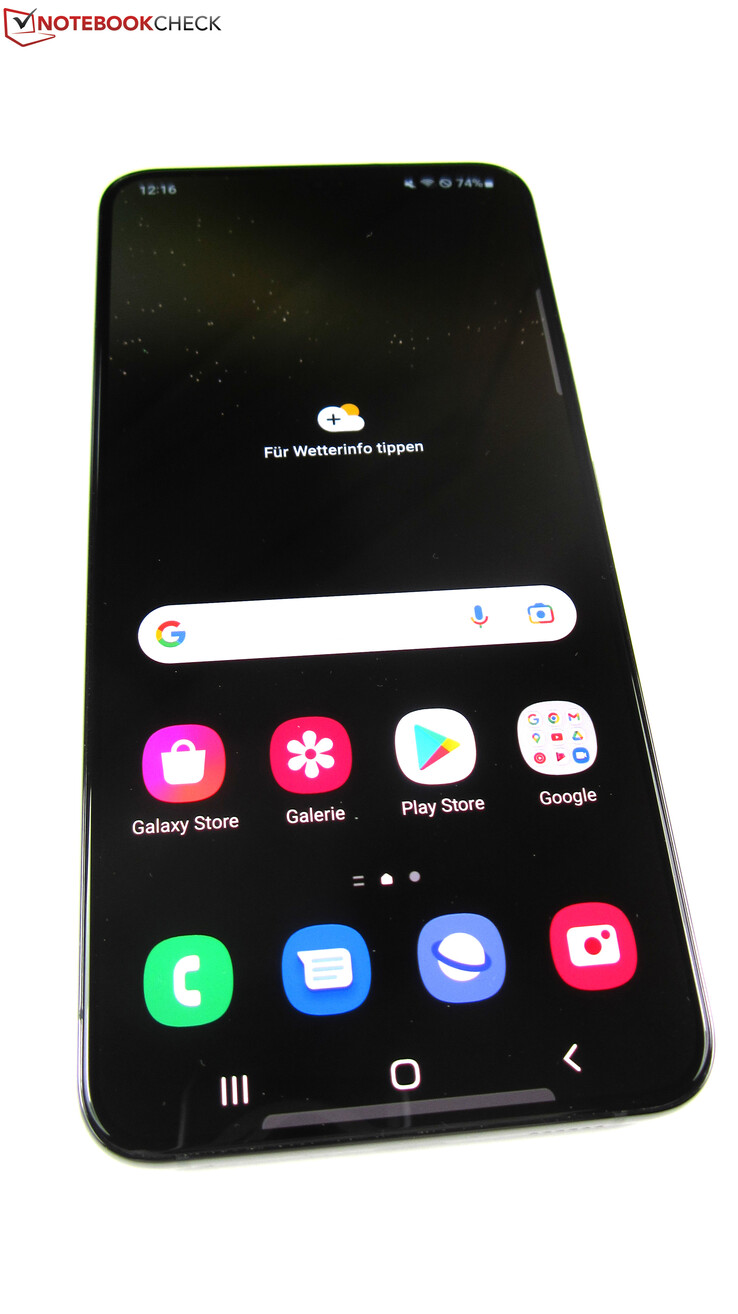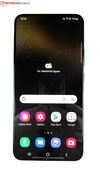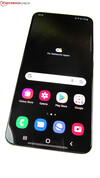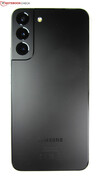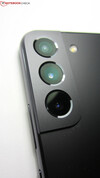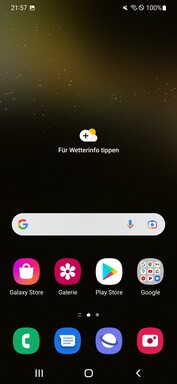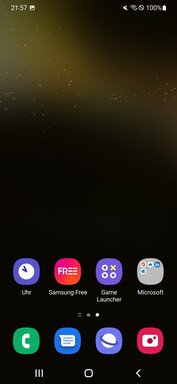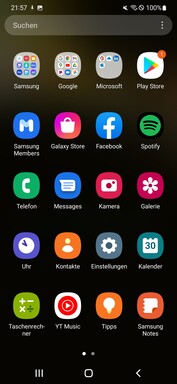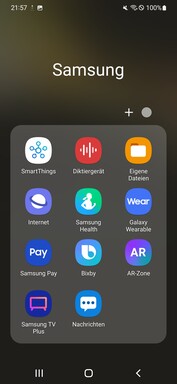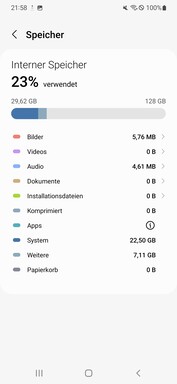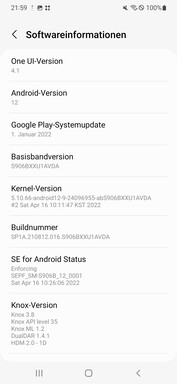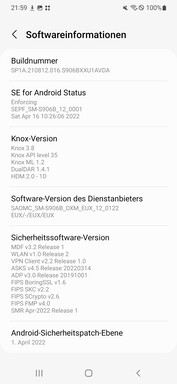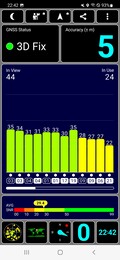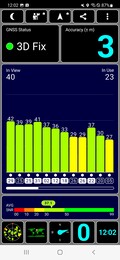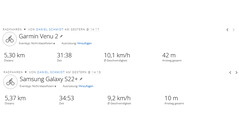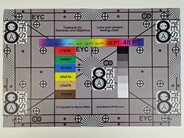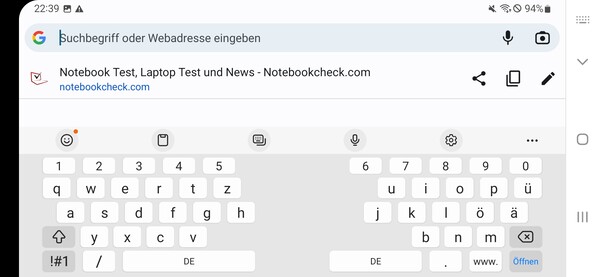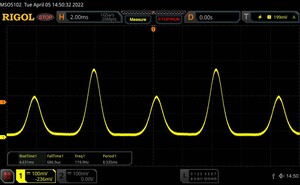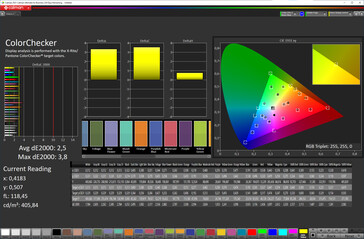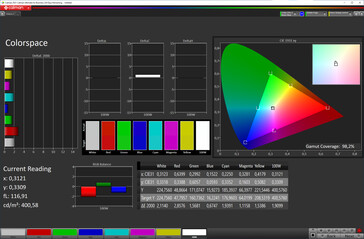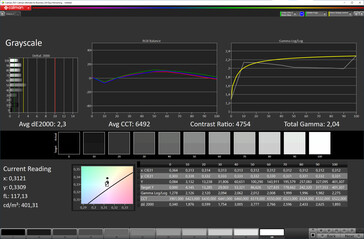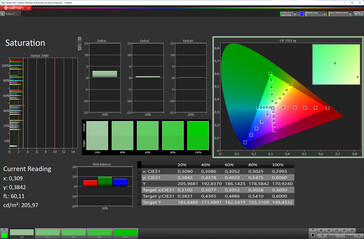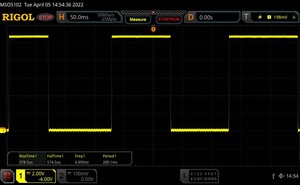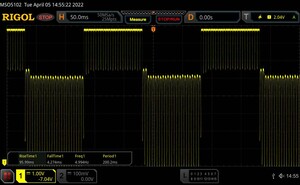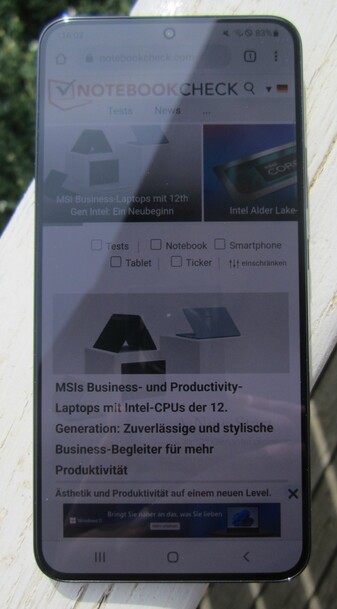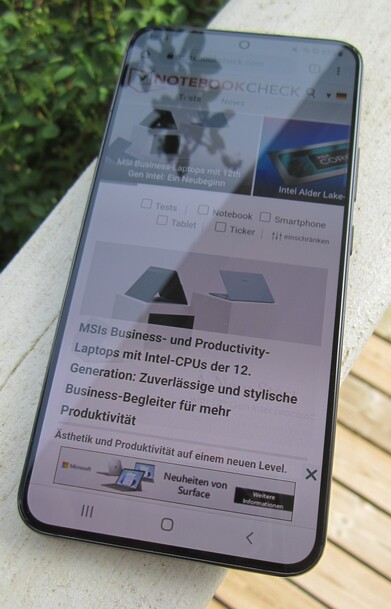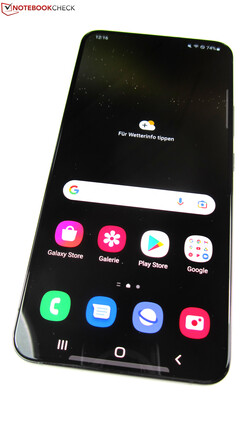Samsung Galaxy S22+ smartphone review: The big version of the Galaxy S22
Samsung traditionally makes its flagship smartphones in the Galaxy S series broadly available so that they appeal to the widest possible range of buyers. 2022 is no exception. At the top is the 6.8-inch Galaxy S22 Ultra, which combines the best elements of both the Galaxy S and Galaxy Note series in one device. The most affordable entry into Samsung's new S class is again the Galaxy S22, which at 6.1 inches has similar dimensions to the Apple iPhone 13, but uses the same SoC as the Galaxy S22 Ultra in the form of the Exynos 2200.
The Galaxy S22+ is the third device to complete the current Galaxy S line-up. In terms of performance, it plays in the same league as its two sister models thanks to the use of the same SoC. In terms of features and price, however, it is much closer to the Galaxy S22 than to the Galaxy S22 Ultra.
Possible Competitors in Comparison
Rating | Date | Model | Weight | Drive | Size | Resolution | Price |
|---|---|---|---|---|---|---|---|
| 88.9 % v7 (old) | 05 / 2022 | Samsung Galaxy S22+ Exynos 2200, Xclipse 920 | 196 g | 128 GB UFS 3.1 Flash | 6.60" | 2340x1080 | |
| 90.5 % v7 (old) | 10 / 2021 | Apple iPhone 13 Pro Max A15, A15 GPU 5-Core | 238 g | 128 GB NVMe | 6.70" | 2778x1284 | |
| 88.1 % v7 (old) | 06 / 2022 | OnePlus 10 Pro SD 8 Gen 1, Adreno 730 | 200.5 g | 256 GB UFS 3.1 Flash | 6.70" | 3216x1440 | |
| 89.2 % v7 (old) | 04 / 2022 | Oppo Find X5 Pro SD 8 Gen 1, Adreno 730 | 221 g | 256 GB UFS 3.1 Flash | 6.70" | 3216x1440 | |
| 89.6 % v7 (old) | 02 / 2021 | Samsung Galaxy S21+ Exynos 2100 5G, Mali-G78 MP14 | 200 g | 128 GB UFS 3.1 Flash | 6.70" | 2400x1080 | |
| 87.6 % v7 (old) | 02 / 2022 | Xiaomi 12 Pro SD 8 Gen 1, Adreno 730 | 204 g | 256 GB UFS 3.1 Flash | 6.73" | 3200x1440 |
Case: High-quality glass chassis with aluminium frame
The Galaxy S22+ uses a frameless and flat design throughout with rounded corners, making it very similar to the Apple iPhone 13 Pro Max. Apart from the smaller form factor, the Galaxy S22 uses exactly the same casing, which is IP68-certified. Accordingly, this means the smartphone is dustproof and can survive a 30-minute dive in fresh water up to 1.5 meters without damage.
On the front and back, the Galaxy S22+ is protected by Gorilla Glass Victus+. The binding element is a frame made of Armor Aluminium, which aims to reinforce the rigidity of the smartphone and actually makes it extremely resistant to any attempt to dent or twist it. All in all, the Samsung Galaxy S22+ looks and feels very high-quality.
The most striking design element on the back is the triple camera, which protrudes a few millimeters from the casing and is enclosed on two sides by the aforementioned metal frame that connects the display and back cover. The matte surface finish of the back cover matches well with the "clean" look of the front and also makes the smartphone rather resistant to fingerprints.
Samsung offers the Galaxy S22+ in "Phantom Black" (like our review device) and in the case colors of "Phantom White", "Green" and "Pink Gold". In addition, there are other color variants such as "Graphite", "Cream", "Violet" and "Sky Blue", which are only available in the Samsung shop.
Hardware: 8 GB RAM and up to 256 GB storage in the Galaxy S22+
Samsung offers the Galaxy S22+ in two storage variants. With 8 GB of LPDDR5 RAM and 128 GB of UFS 3.1 memory, the smartphone costs US$ 749.99, while the variant with 8/256 GB costs US$ 1,079.99. The internal memory cannot be expanded due to the lack of a microSD slot.
The USB-C port of the Galaxy S22+ works at USB 3.2 Gen.1 speed and achieved data rates of around 300 MB/s under testing. It can also be used as an audio port with an adapter. Moreover, the USB-C port supports USB OTB and can be used to connect peripheral devices.
Software: OS updates up to Android 16
The Galaxy S22+ runs Android 12 and the manufacturer's own One UI 4.1 interface. At the time of testing (mid-April), the Android security patches were from 01 April - it doesn't get any more up to date than this.
The OS and preinstalled apps reduce the free storage space on our 128 GB review device to around 98 GB. The ROM comes with only a few third-party apps, such as Facebook and Spotify, as well as a handful of Microsoft tools. Excluding OneDrive, which can be deactivated at the very least, all third-party apps can be uninstalled.
Of particular interest to buyers: The Galaxy S22+ will receive up to four Android OS upgrades and five years of security patches, so users will likely be able to enjoy using the smartphone up to and including Android 16. Under the S21 series, users received updates for a year less (with the exception of the Enterprise edition).
Communication and GNSS: UWB chip and WiFi 6E
The Samsung Galaxy S22+ supports a wide range of mobile frequencies, including 17 5G bands, so you should have good reception everywhere. It differs from the Galaxy S22 in two ways regarding its communication features, which include Bluetooth 5.2 and NFC: The Galaxy S22+ has an ultra-wideband (UWB) chip and offers WiFi 6E instead of WiFi 6.
In the practical Wi-Fi test with our Asus ROG Rapture GT-AXE11000 reference router, the Galaxy S22+ achieved very high transfer rates with peak values of over 1500 Mbps. In WiFi 6 mode, the data throughput remains high and stable, but is significantly reduced compared to WiFi 6E.
| Networking | |
| iperf3 receive AXE11000 | |
| Xiaomi 12 Pro | |
| OnePlus 10 Pro | |
| Samsung Galaxy S22+ | |
| Oppo Find X5 Pro | |
| Average of class Smartphone (52 - 1857, n=181, last 2 years) | |
| iperf3 transmit AXE11000 | |
| Xiaomi 12 Pro | |
| Samsung Galaxy S22+ | |
| OnePlus 10 Pro | |
| Oppo Find X5 Pro | |
| Average of class Smartphone (49.8 - 1828, n=181, last 2 years) | |
| iperf3 transmit AXE11000 6GHz | |
| Samsung Galaxy S22+ | |
| Average of class Smartphone (508 - 1945, n=95, last 2 years) | |
| iperf3 receive AXE11000 6GHz | |
| Samsung Galaxy S22+ | |
| Average of class Smartphone (451 - 1870, n=95, last 2 years) | |
| iperf3 transmit AX12 | |
| Apple iPhone 13 Pro Max | |
| Samsung Galaxy S21+ | |
| Samsung Galaxy S21+ | |
| iperf3 receive AX12 | |
| Samsung Galaxy S21+ | |
| Samsung Galaxy S21+ | |
| Apple iPhone 13 Pro Max | |
In matters of navigation, the Galaxy S22+ uses data derived from GPS (B1, B5), Glonass (B1), Beidou (B1, B2a), Galileo (B1, B5a) and QZSS. Indoors, location accuracy was up to 5 meters, outdoors up to 3 meters.
The outdoor practice test also showed that the Galaxy S22+ provides accurate location data and is very well suited for navigation tasks. On a 5-kilometre-long bicycle ride, the smartphone pinpointed our location nearly as precisely as the Garmin Venu 2 (navigation device used for comparison). The Galaxy S22+ is not so quite on point in densely built-up areas, but this is unlikely to make a difference in everyday life.
Phone Functions & Voice Quality
The Galaxy S22+ provides very good voice quality. Voices sound natural and are easy to understand even in noisy environments. Upon activation of the loudspeaker, sound quality and intelligbility remained solid although there were some slight voice reverberations from time to time.
In addition to VoLTE, the Galaxy S22 also supports WLAN calls. The first option can be found in the connection settings while Wi-Fi calling can be activated in the phone app.
Cameras: Good triple camera with OIS
The Galaxy S22+ and Galaxy S22 share the same triple camera setup, which consists of a 50 MP wide-angle camera with an optical image stabilizer (OIS), a 12 MP ultra-wide-angle camera, and a 10 MP telephoto camera with OIS and 3x optical zoom. The 10 MP front camera is integrated into the display via a small round opening and takes well-balanced selfies.
The Galaxy S22+ is the right smartphone for users who do not want to deal with recording parameters such as aperture, exposure and white balance. In the "Pro" mode of the camera software, you can of course configure all important shooting settings yourself. The standard "Photo" mode, which automatically selects the best scene settings, produces almost equally good photos. They please with natural-looking colors, high contrasts and strong detail. As is typical for Samsung, however, the camera software occasionally tends to oversaturate images.
Night shots are often the Achilles heel of smartphones. Fortunately, this does not apply to the Galaxy S22+. Its main camera takes comparatively good and surprisingly detailed pictures even in low light. The telephoto camera brings subjects closer with a 3x optical zoom which, in combination with optical image stabilization, also results in good images. The digital zoom offers up to 30x magnification. In contrast to the main and telecamera, the ultrawide-angle camera of the Galaxy S22+ falls behind due to average photos which are rather blurred and noisy at the edges.
The Galaxy S22+ records videos at up to 8K at 24 frames per second. Those who also want to use the telephoto and ultra-wide-angle camera for recording have to limit themselves to 4K at 30 FPS, but these nonetheless compensate with good image quality. Like the Galaxy S22, the Galaxy S22+ can also record videos in HDR10+, which works up to a maximum of 4K at 30 frames per second.
Image comparison
Choose a scene and navigate within the first image. One click changes the position on touchscreens. One click on the zoomed-in image opens the original in a new window. The first image shows the scaled photograph of the test device.
Tageslicht-Aufnahme 1Tageslicht-Aufnahme 25-facher ZoomUltraweitwinkelLowlight-AufnahmeIn the photo lab, we took another closer look at the main camera. Reference colors are reproduced very accurately, with the exception of some darker green and brown tones. The test chart is reproduced completely even at an illumination level of 1 lux, but is still rather blurry.
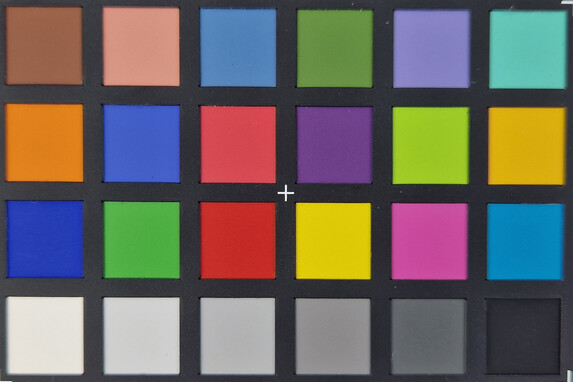
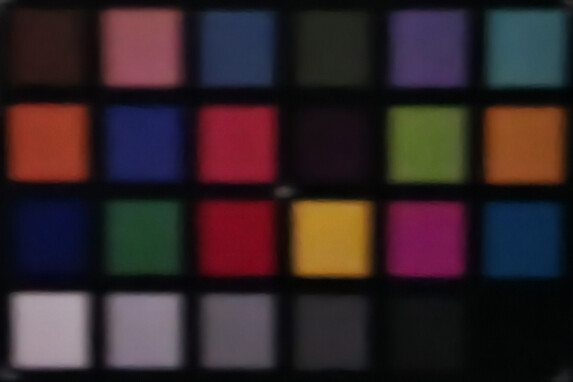
Accessories & Warranty: Optional 45 watt power supply unit
As is already clear from the flat packaging, the Galaxy S22+ does not come with a power supply unit. All that is included is a USB cable (type C to A), a SIM tool and a quick guide as well as leaflets with warranty information. Samsung offers the optional 45-watt fast-charging adapter in its online shop. There, you can also stock up on wireless charging pads, protective cases and headphones, among other things.
The Samsung Galaxy S22 comes with a 24-month warranty, which can be extended via the Samsung Care+ insurance package.
Input Devices & Operation: Ultrasonic fingerprint sensor and 2D face scan
The Samsung Galaxy S22+ can be operated very smoothly and never gave the impression of being overwhelmed by any task in our review. Apps start quickly, switching between open applications takes place without jerks, and finger inputs are handled without any delay. Only when booting up the smartphone do you have to wait a short moment for the user interface to finish loading but this only takes a few seconds.
For authentication, you can use the ultrasonic fingerprint sensor which is hidden under the display and unlocks the smartphone quickly and reliably. The second biometric recognition method is 2D face recognition, which is not quite as reliable as the fingerprint sensor, but nonetheless achieves an equally high hit rate in good lighting conditions.
Display: 120 Hz AMOLED panel with 1500 cd/m²
The 6.6-inch AMOLED display of the Galaxy S22+ has a resolution of 2340x1080 and dynamically adjusts its refresh rate in the range of 10 to 120 Hz under default settings. Nominally, it achieves the same high luminosity as the Galaxy S22 Ultra, namely up to 1750 nits. Under testing, the AMOLED screen does not reach the manufacturer's specification of 1500 cd/m², but still achieves an impressively high luminosity.
Without the brightness sensor, the display shines at a maximum of 419 cd/m², while this increases to 714 cd/m² with the "additional brightness" option activated. At the lowest brightness setting, we measured 1.69 cd/m², which falls to 0.33 cd/m² if you turn on "Extra Dimming" in the Android settings under "Input Help" and "Visibility Improvements".
We also observed the PWM flickering typical of OLED panels when adjusting the brightness on the Galaxy S22+. Depending on the brightness level, this operates at a constant 120 or 240 Hz and should thus cause few or no complaints (even for sensitive users).
| |||||||||||||||||||||||||
Brightness Distribution: 98 %
Center on Battery: 1090 cd/m²
Contrast: ∞:1 (Black: 0 cd/m²)
ΔE ColorChecker Calman: 2.5 | ∀{0.5-29.43 Ø4.78}
ΔE Greyscale Calman: 2.3 | ∀{0.09-98 Ø5}
98.2% sRGB (Calman 2D)
Gamma: 2.04
CCT: 6492 K
| Samsung Galaxy S22+ AMOLED, 2340x1080, 6.6" | Apple iPhone 13 Pro Max OLED, 2778x1284, 6.7" | OnePlus 10 Pro AMOLED, 3216x1440, 6.7" | Oppo Find X5 Pro AMOLED, 3216x1440, 6.7" | Samsung Galaxy S21+ Dynamic AMOLED 2X, 2400x1080, 6.7" | Xiaomi 12 Pro AMOLED, 3200x1440, 6.7" | |
|---|---|---|---|---|---|---|
| Screen | 30% | 17% | 15% | 2% | 11% | |
| Brightness middle (cd/m²) | 1090 | 1049 -4% | 793 -27% | 746 -32% | 814 -25% | 959 -12% |
| Brightness (cd/m²) | 1097 | 1060 -3% | 776 -29% | 744 -32% | 814 -26% | 977 -11% |
| Brightness Distribution (%) | 98 | 98 0% | 95 -3% | 97 -1% | 97 -1% | 96 -2% |
| Black Level * (cd/m²) | ||||||
| Colorchecker dE 2000 * | 2.5 | 0.78 69% | 0.79 68% | 0.9 64% | 2 20% | 1.1 56% |
| Colorchecker dE 2000 max. * | 3.8 | 1.72 55% | 1.93 49% | 1.6 58% | 3.6 5% | 3.1 18% |
| Greyscale dE 2000 * | 2.3 | 0.8 65% | 1.3 43% | 1.6 30% | 1.4 39% | 1.9 17% |
| Gamma | 2.04 108% | 2.181 101% | 2.223 99% | 2.23 99% | 2.12 104% | 2.22 99% |
| CCT | 6492 100% | 6559 99% | 6624 98% | 6499 100% | 6568 99% | 6498 100% |
* ... smaller is better
Screen Flickering / PWM (Pulse-Width Modulation)
| Screen flickering / PWM detected | 240 Hz | ||
The display backlight flickers at 240 Hz (worst case, e.g., utilizing PWM) . The frequency of 240 Hz is relatively low, so sensitive users will likely notice flickering and experience eyestrain at the stated brightness setting and below. In comparison: 53 % of all tested devices do not use PWM to dim the display. If PWM was detected, an average of 8111 (minimum: 5 - maximum: 343500) Hz was measured. | |||
Messreihe mit fixer Zoomstufe und unterschiedlichen Helligkeitseinstellungen
In the display settings, users can choose between "Vivid" and "Natural". The Galaxy S22+ delivers the best display quality under the latter setting. With delta E values of less than 3 in each case, the deviations for colors and grayscales are just as much in the ideal range as the color temperature and the RGB balance.
Display Response Times
| ↔ Response Time Black to White | ||
|---|---|---|
| 1.153 ms ... rise ↗ and fall ↘ combined | ↗ 0.5785 ms rise | |
| ↘ 0.5745 ms fall | ||
| The screen shows very fast response rates in our tests and should be very well suited for fast-paced gaming. In comparison, all tested devices range from 0.1 (minimum) to 240 (maximum) ms. » 5 % of all devices are better. This means that the measured response time is better than the average of all tested devices (20.2 ms). | ||
| ↔ Response Time 50% Grey to 80% Grey | ||
| 8.548 ms ... rise ↗ and fall ↘ combined | ↗ 4.274 ms rise | |
| ↘ 4.274 ms fall | ||
| The screen shows fast response rates in our tests and should be suited for gaming. In comparison, all tested devices range from 0.165 (minimum) to 636 (maximum) ms. » 21 % of all devices are better. This means that the measured response time is better than the average of all tested devices (31.6 ms). | ||
Performance: High-end SoC with room for improvement
In addition to the Galaxy S22+, the Galaxy S22 and the Galaxy S22 Ultra also use the Exynos 2200 and thus the same high-end SoC. The octa-core processor is currently one of the fastest smartphone CPUs, but is still not quite sufficient to match the top dogs. Competitors such as the Snapdragon 8 Gen 1 or the Apple A15 Bionic are even faster.
| CrossMark - Overall | |
| OnePlus 10 Pro | |
| Average of class Smartphone (187 - 2674, n=126, last 2 years) | |
| Samsung Galaxy S22+ | |
| Average Samsung Exynos 2200 (888 - 1129, n=4) | |
| Oppo Find X5 Pro | |
| Xiaomi 12 Pro | |
| AImark - Score v2.x | |
| Samsung Galaxy S21+ | |
| Apple iPhone 13 Pro Max | |
| Xiaomi 12 Pro | |
| Average Samsung Exynos 2200 (6217 - 6487, n=3) | |
| Samsung Galaxy S22+ | |
| OnePlus 10 Pro | |
| Oppo Find X5 Pro | |
The Xclipse 920 GPU integrated in the Samsung Exynos 2200 is undoubtedly one of the fastest of its kind, but it does not reach the processing power of the Adreno 730 and Apple Bionic A15 GPUs used in the Snapdragon 8 Gen 1 and the Apple A15 Bionic, respectively.
GFXBench (DX / GLBenchmark) 2.7: T-Rex Onscreen | 1920x1080 T-Rex Offscreen
GFXBench 3.0: on screen Manhattan Onscreen OGL | 1920x1080 1080p Manhattan Offscreen
GFXBench 3.1: on screen Manhattan ES 3.1 Onscreen | 1920x1080 Manhattan ES 3.1 Offscreen
GFXBench: on screen Car Chase Onscreen | 1920x1080 Car Chase Offscreen | on screen Aztec Ruins High Tier Onscreen | 2560x1440 Aztec Ruins High Tier Offscreen | on screen Aztec Ruins Normal Tier Onscreen | 1920x1080 Aztec Ruins Normal Tier Offscreen
| 3DMark / Wild Life Extreme Unlimited | |
| Apple iPhone 13 Pro Max | |
| OnePlus 10 Pro | |
| Oppo Find X5 Pro | |
| Xiaomi 12 Pro | |
| Samsung Galaxy S22+ | |
| 3DMark / Wild Life Extreme | |
| Apple iPhone 13 Pro Max | |
| OnePlus 10 Pro | |
| Xiaomi 12 Pro | |
| Oppo Find X5 Pro | |
| Samsung Galaxy S22+ | |
| 3DMark / Wild Life Unlimited Score | |
| Apple iPhone 13 Pro Max | |
| Xiaomi 12 Pro | |
| OnePlus 10 Pro | |
| Oppo Find X5 Pro | |
| Samsung Galaxy S22+ | |
| Samsung Galaxy S21+ | |
| 3DMark / Wild Life Score | |
| OnePlus 10 Pro | |
| Xiaomi 12 Pro | |
| Oppo Find X5 Pro | |
| Apple iPhone 13 Pro Max | |
| Samsung Galaxy S22+ | |
| Samsung Galaxy S21+ | |
| 3DMark / Sling Shot Extreme (ES 3.1) Unlimited Physics | |
| Xiaomi 12 Pro | |
| Samsung Galaxy S21+ | |
| OnePlus 10 Pro | |
| Samsung Galaxy S22+ | |
| Oppo Find X5 Pro | |
| Apple iPhone 13 Pro Max | |
| 3DMark / Sling Shot Extreme (ES 3.1) Unlimited Graphics | |
| OnePlus 10 Pro | |
| Oppo Find X5 Pro | |
| Apple iPhone 13 Pro Max | |
| Samsung Galaxy S22+ | |
| Xiaomi 12 Pro | |
| Samsung Galaxy S21+ | |
| 3DMark / Sling Shot Extreme (ES 3.1) Unlimited | |
| OnePlus 10 Pro | |
| Oppo Find X5 Pro | |
| Xiaomi 12 Pro | |
| Samsung Galaxy S22+ | |
| Samsung Galaxy S21+ | |
| Apple iPhone 13 Pro Max | |
| 3DMark / Sling Shot OpenGL ES 3.0 Unlimited | |
| Oppo Find X5 Pro | |
| OnePlus 10 Pro | |
| Samsung Galaxy S22+ | |
| Xiaomi 12 Pro | |
| Samsung Galaxy S21+ | |
| 3DMark / Sling Shot OpenGL ES 3.0 Unlimited Graphics | |
| Oppo Find X5 Pro | |
| OnePlus 10 Pro | |
| Samsung Galaxy S22+ | |
| Xiaomi 12 Pro | |
| Samsung Galaxy S21+ | |
| 3DMark / Sling Shot OpenGL ES 3.0 Unlimited Physics | |
| Oppo Find X5 Pro | |
| Xiaomi 12 Pro | |
| Samsung Galaxy S22+ | |
| OnePlus 10 Pro | |
| GFXBench (DX / GLBenchmark) 2.7 / T-Rex Onscreen | |
| Xiaomi 12 Pro | |
| Samsung Galaxy S21+ | |
| Samsung Galaxy S22+ | |
| Apple iPhone 13 Pro Max | |
| OnePlus 10 Pro | |
| Oppo Find X5 Pro | |
| GFXBench (DX / GLBenchmark) 2.7 / T-Rex Offscreen | |
| Xiaomi 12 Pro | |
| Apple iPhone 13 Pro Max | |
| Oppo Find X5 Pro | |
| OnePlus 10 Pro | |
| Samsung Galaxy S22+ | |
| Samsung Galaxy S21+ | |
| GFXBench 3.0 / Manhattan Onscreen OGL | |
| Samsung Galaxy S21+ | |
| Samsung Galaxy S22+ | |
| Xiaomi 12 Pro | |
| Apple iPhone 13 Pro Max | |
| OnePlus 10 Pro | |
| Oppo Find X5 Pro | |
| GFXBench 3.0 / 1080p Manhattan Offscreen | |
| Xiaomi 12 Pro | |
| Apple iPhone 13 Pro Max | |
| Samsung Galaxy S22+ | |
| OnePlus 10 Pro | |
| Oppo Find X5 Pro | |
| Samsung Galaxy S21+ | |
| GFXBench 3.1 / Manhattan ES 3.1 Onscreen | |
| Samsung Galaxy S22+ | |
| Samsung Galaxy S21+ | |
| Xiaomi 12 Pro | |
| Apple iPhone 13 Pro Max | |
| OnePlus 10 Pro | |
| Oppo Find X5 Pro | |
| GFXBench 3.1 / Manhattan ES 3.1 Offscreen | |
| Xiaomi 12 Pro | |
| Apple iPhone 13 Pro Max | |
| OnePlus 10 Pro | |
| Samsung Galaxy S22+ | |
| Oppo Find X5 Pro | |
| Samsung Galaxy S21+ | |
| GFXBench / Car Chase Onscreen | |
| Samsung Galaxy S22+ | |
| OnePlus 10 Pro | |
| Samsung Galaxy S21+ | |
| Apple iPhone 13 Pro Max | |
| Oppo Find X5 Pro | |
| Xiaomi 12 Pro | |
| GFXBench / Car Chase Offscreen | |
| Apple iPhone 13 Pro Max | |
| Samsung Galaxy S22+ | |
| Xiaomi 12 Pro | |
| OnePlus 10 Pro | |
| Oppo Find X5 Pro | |
| Samsung Galaxy S21+ | |
| GFXBench / Aztec Ruins High Tier Onscreen | |
| OnePlus 10 Pro | |
| Apple iPhone 13 Pro Max | |
| Samsung Galaxy S22+ | |
| Samsung Galaxy S21+ | |
| Oppo Find X5 Pro | |
| Xiaomi 12 Pro | |
| GFXBench / Aztec Ruins High Tier Offscreen | |
| OnePlus 10 Pro | |
| Oppo Find X5 Pro | |
| Apple iPhone 13 Pro Max | |
| Xiaomi 12 Pro | |
| Samsung Galaxy S22+ | |
| Samsung Galaxy S21+ | |
| GFXBench / Aztec Ruins Normal Tier Onscreen | |
| Samsung Galaxy S22+ | |
| Samsung Galaxy S21+ | |
| OnePlus 10 Pro | |
| Apple iPhone 13 Pro Max | |
| Oppo Find X5 Pro | |
| Xiaomi 12 Pro | |
| GFXBench / Aztec Ruins Normal Tier Offscreen | |
| Apple iPhone 13 Pro Max | |
| OnePlus 10 Pro | |
| Oppo Find X5 Pro | |
| Xiaomi 12 Pro | |
| Samsung Galaxy S21+ | |
| Samsung Galaxy S22+ | |
In terms of browser performance, the Samsung Galaxy S22+ delivers very solid performance. Like all other Android smartphones, however, it appears out of its depth against the Apple iPhone 13 Pro Max.
| Jetstream 2 - 2.0 Total Score | |
| Apple iPhone 13 Pro Max (Safari 15) | |
| Average of class Smartphone (23.8 - 387, n=152, last 2 years) | |
| Samsung Galaxy S22+ (Chrome 100.0.4896.127) | |
| Oppo Find X5 Pro (Chrome 99) | |
| OnePlus 10 Pro (Chrome100) | |
| Xiaomi 12 Pro (Chrome 97) | |
| Average Samsung Exynos 2200 (13.8 - 107.4, n=4) | |
| Samsung Galaxy S21+ (Chrome 88.0.4324.152) | |
| JetStream 1.1 - Total Score | |
| Apple iPhone 13 Pro Max (Safari 15) | |
| Oppo Find X5 Pro (Chrome 99) | |
| OnePlus 10 Pro | |
| Average Samsung Exynos 2200 (118.9 - 200, n=3) | |
| Xiaomi 12 Pro (Chrome 97) | |
| Samsung Galaxy S22+ (Chrome 100.0.4896.127) | |
| Samsung Galaxy S21+ (Chrome 88.0.4324.152) | |
| Speedometer 2.0 - Result 2.0 | |
| Apple iPhone 13 Pro Max (Safari 15) | |
| Average of class Smartphone (15.2 - 643, n=126, last 2 years) | |
| OnePlus 10 Pro (Chrome100) | |
| Average Samsung Exynos 2200 (105 - 137, n=4) | |
| Samsung Galaxy S22+ (Chrome 100.0.4896.127) | |
| Oppo Find X5 Pro (Chrome 99) | |
| Samsung Galaxy S21+ (Chrome 88.0.4324.152) | |
| Xiaomi 12 Pro (Chrome 97) | |
| WebXPRT 3 - Overall | |
| Apple iPhone 13 Pro Max (Safari 15) | |
| OnePlus 10 Pro (Chrome100) | |
| Average of class Smartphone (38 - 380, n=34, last 2 years) | |
| Samsung Galaxy S22+ (Chrome 100.0.4896.127) | |
| Average Samsung Exynos 2200 (124 - 153, n=3) | |
| Oppo Find X5 Pro (Chrome 99) | |
| Xiaomi 12 Pro (Chrome 97) | |
| Samsung Galaxy S21+ (Chrome 88.0.4324.152) | |
| Octane V2 - Total Score | |
| Apple iPhone 13 Pro Max (Safari 15) | |
| OnePlus 10 Pro (Chrome100) | |
| Average of class Smartphone (2228 - 121337, n=200, last 2 years) | |
| Samsung Galaxy S22+ (Chrome 100.0.4896.127) | |
| Average Samsung Exynos 2200 (34055 - 51202, n=4) | |
| Oppo Find X5 Pro (Chrome 99) | |
| Xiaomi 12 Pro (Chrome 97) | |
| Samsung Galaxy S21+ (Chrome 88.0.4324.152) | |
| Mozilla Kraken 1.1 - Total | |
| Samsung Galaxy S21+ (Chrome 88.0.4324.152) | |
| Samsung Galaxy S22+ (Chrome 100.0.4896.127) | |
| Xiaomi 12 Pro (Chrome 97) | |
| Average Samsung Exynos 2200 (840 - 1566, n=4) | |
| Average of class Smartphone (257 - 28190, n=155, last 2 years) | |
| Oppo Find X5 Pro (Chrome 99) | |
| OnePlus 10 Pro (Chrome100) | |
| Apple iPhone 13 Pro Max (Safari 15) | |
* ... smaller is better
The performance of the UFS 3.1 storage is at a high level. Apart from the Oppo Find X5 Pro, its sequential read speed is not quite as high as that of the comparison devices. But this is not noticeable in everyday life because apps start very quickly.
| Samsung Galaxy S22+ | OnePlus 10 Pro | Oppo Find X5 Pro | Samsung Galaxy S21+ | Xiaomi 12 Pro | Average 128 GB UFS 3.1 Flash | Average of class Smartphone | |
|---|---|---|---|---|---|---|---|
| AndroBench 3-5 | 1% | -23% | 0% | 26% | -17% | 32% | |
| Sequential Read 256KB (MB/s) | 1629.99 | 1602.12 -2% | 1410 -13% | 1623 0% | 1620 -1% | 1586 ? -3% | 2216 ? 36% |
| Sequential Write 256KB (MB/s) | 1001.67 | 1253.34 25% | 894 -11% | 1037 4% | 1465 46% | 763 ? -24% | 1837 ? 83% |
| Random Read 4KB (MB/s) | 306.7 | 284.34 -7% | 183.7 -40% | 309.6 1% | 324.9 6% | 243 ? -21% | 294 ? -4% |
| Random Write 4KB (MB/s) | 297.67 | 264.45 -11% | 210.4 -29% | 283.3 -5% | 448.9 51% | 241 ? -19% | 334 ? 12% |
Gaming: Lots of potential for high frame rates
The Exynos 2200 and its Xclipse 920 GPU provide more than enough power to run current games smoothly. The FPS, however, depends primarily on the game played. The AMOLED screen of the Galaxy S22+ manages up to 120 FPS and is also able to fully exploit this advantage in Armajet. In the second test game PUBG Mobile, however, only a maximum of 30 FPS was possible, although there is still a lot more room for improvement. Then again, the frame rate almost never falls below the 30 FPS mark.
Frame rates were determined with our Gamebench test tool.
Emissions: Weak cooling slows down the Exynos 2200
Temperature
The Galaxy S22+ reaches a maximum of 35.3 °C during operation, which does not cause any discomfort when held. Internally, however, the smartphone has to keep the heat of the Exynos 2200 SoC under control with throttling. This happens quite quickly under load as 3DMark's Wild Life Stress tests show. Shortly after starting, the benchmark scores drop and are 58% below the best result in the worst case.
(+) The maximum temperature on the upper side is 35.3 °C / 96 F, compared to the average of 35.2 °C / 95 F, ranging from 21.9 to 247 °C for the class Smartphone.
(+) The bottom heats up to a maximum of 34.4 °C / 94 F, compared to the average of 34 °C / 93 F
(+) In idle usage, the average temperature for the upper side is 25.1 °C / 77 F, compared to the device average of 32.9 °C / 91 F.
3DMark Wild Life Stress Test
| 3DMark | |
| Wild Life Stress Test Stability | |
| Apple iPhone 13 Pro Max | |
| OnePlus 10 Pro | |
| Samsung Galaxy S21+ | |
| Oppo Find X5 Pro | |
| Samsung Galaxy S22+ | |
| Xiaomi 12 Pro | |
| Wild Life Extreme Stress Test | |
| Apple iPhone 13 Pro Max | |
| OnePlus 10 Pro | |
| Oppo Find X5 Pro | |
| Samsung Galaxy S22+ | |
| Xiaomi 12 Pro | |
Speakers
The two speakers of the Galaxy S22+ can play loudly up to 91.3 dB(A) and deliver fairly balanced sound overall even if bass tones can hardly be heard.
Wired headphones or speakers can be connected via a USB-C adapter. The Bluetooth codecs AAC, aptX, LDAC and SBC are available for wireless connection.
Samsung Galaxy S22+ audio analysis
(+) | speakers can play relatively loud (91.3 dB)
Bass 100 - 315 Hz
(-) | nearly no bass - on average 23.2% lower than median
(±) | linearity of bass is average (7.1% delta to prev. frequency)
Mids 400 - 2000 Hz
(±) | higher mids - on average 5.5% higher than median
(+) | mids are linear (4.5% delta to prev. frequency)
Highs 2 - 16 kHz
(±) | higher highs - on average 5.8% higher than median
(+) | highs are linear (6.1% delta to prev. frequency)
Overall 100 - 16.000 Hz
(±) | linearity of overall sound is average (18% difference to median)
Compared to same class
» 16% of all tested devices in this class were better, 8% similar, 76% worse
» The best had a delta of 11%, average was 35%, worst was 134%
Compared to all devices tested
» 37% of all tested devices were better, 8% similar, 55% worse
» The best had a delta of 4%, average was 24%, worst was 134%
Apple iPhone 13 Pro Max audio analysis
(±) | speaker loudness is average but good (80.2 dB)
Bass 100 - 315 Hz
(-) | nearly no bass - on average 16.8% lower than median
(±) | linearity of bass is average (9.5% delta to prev. frequency)
Mids 400 - 2000 Hz
(+) | balanced mids - only 4.1% away from median
(+) | mids are linear (4.2% delta to prev. frequency)
Highs 2 - 16 kHz
(+) | balanced highs - only 4.8% away from median
(±) | linearity of highs is average (7.5% delta to prev. frequency)
Overall 100 - 16.000 Hz
(±) | linearity of overall sound is average (16.7% difference to median)
Compared to same class
» 8% of all tested devices in this class were better, 6% similar, 86% worse
» The best had a delta of 11%, average was 35%, worst was 134%
Compared to all devices tested
» 28% of all tested devices were better, 7% similar, 65% worse
» The best had a delta of 4%, average was 24%, worst was 134%
Battery life: Slightly more stamina than the predecessor
Power Consumption
The Galaxy S22+ is inconspicuous in terms of power consumption. However, power consumption increases significantly under load and is also higher than that of the comparison devices.
The 4500 mAh battery of the Galaxy S22+ can be charged with up to 45 watts. Users have to acquire a matching power supply separately because Samsung does not include one with the smartphone. The Galaxy S22 Ultra offers the same charging power as the Galaxy S22+, but has a larger battery (5000 mAh). At the other end of the current Galaxy S line-up is the Galaxy S22 with a 3700 mAh capacity and a charging power capactiy of 25 watts.
Up to 15 W wireless charging is supported on the Galaxy S22+. With the Wireless PowerShare function, the smartphone can also charge other compatible Galaxy devices wirelessly.
| Off / Standby | |
| Idle | |
| Load |
|
Key:
min: | |
| Samsung Galaxy S22+ 4500 mAh | Apple iPhone 13 Pro Max 4352 mAh | OnePlus 10 Pro 5000 mAh | Oppo Find X5 Pro 5000 mAh | Samsung Galaxy S21+ 4800 mAh | Xiaomi 12 Pro 4600 mAh | Average Samsung Exynos 2200 | Average of class Smartphone | |
|---|---|---|---|---|---|---|---|---|
| Power Consumption | 10% | -8% | -8% | -3% | -3% | -6% | -19% | |
| Idle Minimum * (Watt) | 0.71 | 0.6 15% | 0.7 1% | 1.24 -75% | 0.74 -4% | 0.94 -32% | 0.668 ? 6% | 0.848 ? -19% |
| Idle Average * (Watt) | 1.1 | 1.5 -36% | 1.1 -0% | 1.39 -26% | 1.27 -15% | 1.24 -13% | 1.038 ? 6% | 1.434 ? -30% |
| Idle Maximum * (Watt) | 1.19 | 1.6 -34% | 1.7 -43% | 1.42 -19% | 1.33 -12% | 1.34 -13% | 1.218 ? -2% | 1.618 ? -36% |
| Load Average * (Watt) | 7.74 | 3.5 55% | 6.4 17% | 3.58 54% | 6.32 18% | 5.7 26% | 9.43 ? -22% | 7.01 ? 9% |
| Load Maximum * (Watt) | 9.64 | 4.8 50% | 11.3 -17% | 6.99 27% | 9.61 -0% | 8.12 16% | 11.5 ? -19% | 11.3 ? -17% |
* ... smaller is better
Power Consumption: Geekbench (150 cd/m²)
Power Consumption: GFXBench (150 cd/m²)
Battery Life
With 13 hours of simulated web surfing and 17 hours of video playback, the Samsung Galaxy S22+ achieves good battery runtimes. Although the smartphone does not reach the level of the Apple iPhone 13 Pro Max, it beats all Android comparison devices and its predecessor, the Galaxy S21+ (even though these have slightly larger batteries).
| Samsung Galaxy S22+ 4500 mAh | Apple iPhone 13 Pro Max 4352 mAh | OnePlus 10 Pro 5000 mAh | Oppo Find X5 Pro 5000 mAh | Samsung Galaxy S21+ 4800 mAh | Xiaomi 12 Pro 4600 mAh | |
|---|---|---|---|---|---|---|
| Battery runtime | 30% | -15% | -10% | -14% | -14% | |
| Reader / Idle (h) | 42.9 | 47.4 10% | 27 -37% | 21.2 -51% | 29.7 -31% | 33.9 -21% |
| H.264 (h) | 17 | 25.4 49% | 18.7 10% | 19 12% | 19.6 15% | 13.1 -23% |
| WiFi v1.3 (h) | 13.1 | 17.8 36% | 12.8 -2% | 13.1 0% | 10.9 -17% | 12.8 -2% |
| Load (h) | 6.1 | 7.5 23% | 4.3 -30% | 6.1 0% | 4.7 -23% | 5.6 -8% |
Pros
Cons
Verdict of the Samsung Galaxy S22+
The Samsung Galaxy S22+ shares the same stylish design as the Galaxy S22 and also the same verdict as its smaller Galaxy S22 counterpart: Here, Samsung has again produced an extremely solid package overall that impresses with excellent workmanship, solid aesthetics and strong performance.
Compared to the 6.7-inch Galaxy S21+, the Galaxy S22+ has become slightly smaller at 6.6 inches. Despite a smaller battery, battery runtimes have improved by more than 10 percent. However, the predecessor did also have an adaptive 120 Hz display, a decent triple camera, 5G with dual SIM and eSIM as well as an ultra-wideband chip (UWB).
The Samsung Galaxy S22+ is a very solid high-end smartphone. Compared to its strong predecessor, the display has improved significantly.
The Galaxy S22+ differs from the 6.1-inch Galaxy S22 entry-level model only in a few respects, but these can be decisive for the purchase. The Galaxy S22+ is significantly larger than its sister model and uses the super-bright AMOLED display of the Galaxy S22 Ultra. This means it has even more luminance reserves than the already very bright Galaxy S22.
The Galaxy S22+ is also somewhat better equipped in terms of communication and battery. It has a UWB chip, WiFi 6E and a higher charging speed (45 instead of a maximum of 25 watts), which the Galaxy S22 does not possess. However, a power supply unit is not included in delivery.
Alternatives to the Galaxy S22+ include the more expensive and faster Apple iPhone 13 Pro Max, which is very similar to the Samsung smartphone in terms of design. Also faster, but similarly priced, are the OnePlus 10 Pro and the Xiaomi 12 Pro.
Price and Availability
At the time of publishing, the Samsung Galaxy S22+ was available via Amazon US in the two storage variants of 128 GB for US$ 749.99 and 256 GB for US$ 1,079.99.
Samsung Galaxy S22+
- 08/30/2022 v7 (old)
Manuel Masiero




